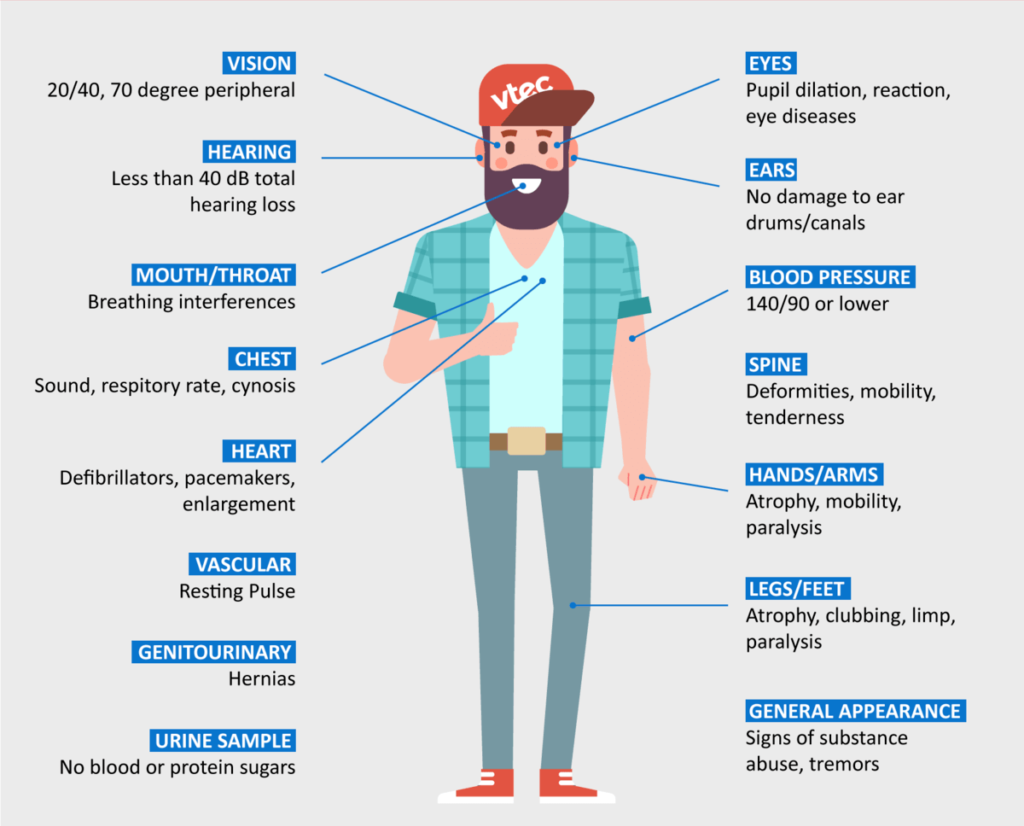Dreaming of a career as a commercial driver? First, you must meet specific physical standards outlined in the CDL medical exam. The physical examination by the Department of Transportation (DOT) ensures that drivers can adequately manage and work with big vehicles such as semi-trucks or buses on public roads.
In this guide, we will explain everything you need to know about the CDL medical exam, from what exactly it is, to who needs it, and a step-by-step process to obtain a CDL medical card. Keep reading to ensure your physical eligibility for a CDL.
What is the CDL medical exam?
According to the FMCSA, the CDL medical examination, also known as the DOT physical test, is a comprehensive health test conducted for commercial vehicle drivers to determine whether they are physically, mentally, and emotionally capable of driving safely. Administered by certified medical examiners, this test determines a driver’s eligibility for the DOT’s Medical Examinier’s Certificate (MEC).
Upon completing the exam, you are given a MEC which is valid for 24 months. If you have any health conditions requiring periodic monitoring such as high blood pressure or sleep apnea, the MEC can be issued for a shorter period, often 12 months or less.

Who needs to undergo a CDL medical exam?
The CDL medical exam is required for drivers of commercial vehicles that:
- Intrastate drivers driving across state lines
- Carry hazardous materials that need a placard
- Carry 16 or more passengers, including the driver
- Carry 8 or more paying passengers
- Have a gross vehicle weight of over 10,000 pounds.

What are the CDL physical requirements?
To pass the CDL medical exam, you must qualify for certain health tests and standards. Here are major DOT physical checklists you must fulfill:
General appearance test

- Your appearance must show that you are not suffering from an acute disease or distress.
- Observations like pallor or icterus can denote more serious illness requiring further investigation.
Vision test

- Visual acuity: At least 20/40 in each eye with or without corrective lenses.
- Peripheral vision: At least 70 inches of peripheral vision in both eyes.
- Color vision: The driver should be able to recognize the color difference between red green and amber.
- Vision exemptions: Although there are some vision exemptions, drivers with some vision impairments may also drive as long as they have some other requirements such as a special exemption from their state.
Hearing test

- Forced whisper test: You must be able to hear a forced whisper from 5 feet away, as recorded by the Code of Federal Regulations, either with or without hearing aids.
- Hearing aids: Drivers who have to use hearing aids must wear their hearing aids while taking the test and anytime they operate a commercial vehicle.
- Other hearing tests like audiometric testing may also be accepted at the discretion of the examiner.
Blood pressure and pulse check

- Acceptable limits: Blood pressure is normally supposed to be less than 140/90 for a two-year certification
- Temporary certification: Greater readings can provide temporary certification, which requires follow-up examinations.
- Management: The drivers having high blood pressure should manage by changing lifestyle or medication.
Throat and mouth test

- Must be capable of respiration and swallowing without difficulty, with no abnormality of the throat and mouth likely to result in obstruction of the airway
- Do not have any severe disorders of the muscles used in swallowing or likely to obstruct the airway, especially during stress or long and continuous driving
Chest and lungs test

- No chronic medical conditions, such as uncontrolled asthma or chronic obstructive pulmonary disease – COPD
- No marked impairment, absent breath sounds, or other signs of abnormal airways
Abdomen test

- The full and normal tone of muscles without abnormal distension or tenderness
- Liver and organs should be palpable for size and tenderness
- An excessive deposit of abdominal fat or protuberances such as a large hernia must be investigated further
Vascular system test

- No severe varicose veins, edema, or carotid artery problems that would interfere with the flow of blood, especially if affecting the lower extremities
- Pulse rate must be regular with no marked arrhythmias
Genito-urinary system test
- No inguinal or other large hernias which can result in discomfort or interfere with driver movements while driving
- No other rectal or genital abnormalities interfere with driver comfort or functioning on long hauls
Extremities test

- Arms, legs, and digits must be intact and fully functional to operate the vehicle controls
- No pronounced deformity or crippling injury that would restrict the movement of any extremity
Neurological health test

- Reflexes should be normal and responsive
- Any neurological conditions such as uncontrolled seizures, are generally disqualifying
- No history of syncope, vertigo, or any other impairment in the state of consciousness or alertness
Health disqualifications
Following are some common health conditions that can affect your eligibility to obtain a CDL:
- Diabetes: You will be disqualified if your blood glucose level is either too high or too low.
- Obesity: An extremely high BMI will raise red flags for examiners due to related sleep apnea and additional testing.
- Sleep apnea: You will be considered disqualified unless you are being treated for this condition.
- Hernias: Large hernias can restrict mobility issues for those required to load or unload cargo.
How to get the CDL medical card
Understanding all CDL medical requirements? Then follow our step-by-step guide below to get your CDL medical card – MEC:
Step 1. Contact a certified medical provider

Find an FMSCA-certified medical professional near you. DOT regulations require that drivers only complete this medical exam with certified professionals, and interstate drivers must meet federal regulations. Utilize the Nationa Registry of Medical Examiners to find your local provider.
Step 2. Take the DOT physical examination

After managing to schedule your checkups, the next important step is to take the DOT physical exam. During the exam, the medical provider will review your medical history and perform a series of health screenings as mentioned above.
Remember to bring all relevant documents with you including any prior medical certifications if available.
Step 3. Apply for your DOT medical card

After the examination, the medical provider will send your medical certification the the state’s DMV. Requirements vary in each state, but generally, you can submit your card by visiting in person, by mail, or using online services.
Note: Renew CDL medical card
You are required to renew your medical card every 24 months, Some conditions, such as sleep apnea and hypertension, require renewal annually. Regular checkups help manage these conditions, ensuring you stay qualified for driving commercial vehicles.
FAQs
1. What do they test your urine for in a DOT physical?
The urinalysis primarily tests for blood sugar or glucose to diagnose diabetes, but it will also test for other indicators of health, such as kidney health.
2. What does your blood pressure have to be to pass a CDL physical?
In general, you will need to have a blood pressure less than 140/90 to pass. If higher, you can qualify with a temporary certification, which will require more frequent checkups.
3. Do you need a DOT physical for a CDL permit?
A DOT physical is not required for all commercial drivers, but depending on your vehicle operation and type of driving route. Normally, drivers who engage in or operate the following need to obtain DOT medical certification:
- A vehicle with a gross weight rating of over 10,000 pounds
- Passenger vehicles carrying more than 16 people including the driver
- Vehicles used for transporting hazardous materials
- Driving interstate
4. Do non-CDL drivers need a DOT physical?
Certain non-CDL drivers of commercial motor vehicles used in interstate commerce may be required to get a DOT physical, depending on the type of vehicle, cargo, or passenger-carrying capacity.
To learn more details, you can read our post on DOT medical card requirements for non-CDL.
5. How can you prepare for the DOT physical exam?
To ensure you are fully prepared for the DOT physical exam, follow these essential steps:
- Bring the necessary documents:
- Remember to bring your current CDL permit or license
- A completed DOT medical examination report form (if possible)
- Previous documents related to medical certification if any
- Medical history:
- Make a list of your case history-surgeries and chronic disorders
- List the present medications you are currently taking, including over-the0counter drugs and supplements
- Avoid alcohol and recreational drugs for at least 24 hours before the exam. Get enough rest the night before the exam
- Diet: Maintain a normal diet in the days leading up to the exam, without consuming excess salt or sugary foods that would increase your blood pressure or glucose level
- Clothing: Wear comfortable clothes through which physical examinations can be easily conducted.
- Know what to expect: Understand what consist on the exam
6. Does the DOT medical exam test for drugs?
No, the DOT physical examination does not require drug testing. It is commonly conducted for the sole purpose of ensuring that the driver is physically and mentally fit to operate a commercial vehicle safely. On the other hand, employers of CDL drivers can require drug testing as part of their hiring process or because their company needs to have a DOT compliance program that includes such drug testing.
7. Will I lose my CDL if my medical card expires in Florida?
Yes! According to the Florida Highway Safety and Motor Vehicles, if your CDL medical card expires and you fail to provide an updated medical card to the DMV, you can lose your CDL. If your medical card is not current, the DMV can also refuse to issue or renew your CDL until you manage to submit a valid medical card.
8. Can I keep my CDL in NC without a medical card?
No, you cannot keep your CDL in North Carolina without a valid DOT medical card. According to the NC’s DMV, drivers who are required to have a certified medical status must maintain their medical certificate with the NC DMV. If your medical card or variance expires and you do not sub, it a new one within 30 days, your driving privileges can be cancelled. You can avoid this by renewing your medical card and forwarding it to the DMV before the expiration date.
9. Can I get my CDL medical card renewed online?
Yes, in most states, you can go online and renew your CDL medical card through the state’s DMV or DOT website by uploading the new medical exam certificate.
Note: The exact process and availability can vary by state. You should go on to your state’s DMV or DOT website for specific instructions on how to renew your CD: medical card online.
10. Is there a grace period for a CDL medical card in Texas?
No, in Texas, there is no grace period for renewing a CDL medical card. Your CDL status can be downgraded after your medical certification has expired. It is highly recommended that you provide your updated medical card to the Texas DMV prior to the expiration date for renewal, to avoid inconveniences.
Final thoughts
In conclusion, this post has walked you through the CDL medical exam’s eligibility criteria, process, and required health standards. Comprehending all these specifications will help you fully prepare to pass the exam, maintain your CDL eligibility, and confidently drive commercial vehicles while ensuring public safety. Start the first step and maintain a healthy lifestyle to get closer to the CDL medical card today! If you have any questions related to the DOT physical exam, do not hesitate to leave a comment or contact us!



